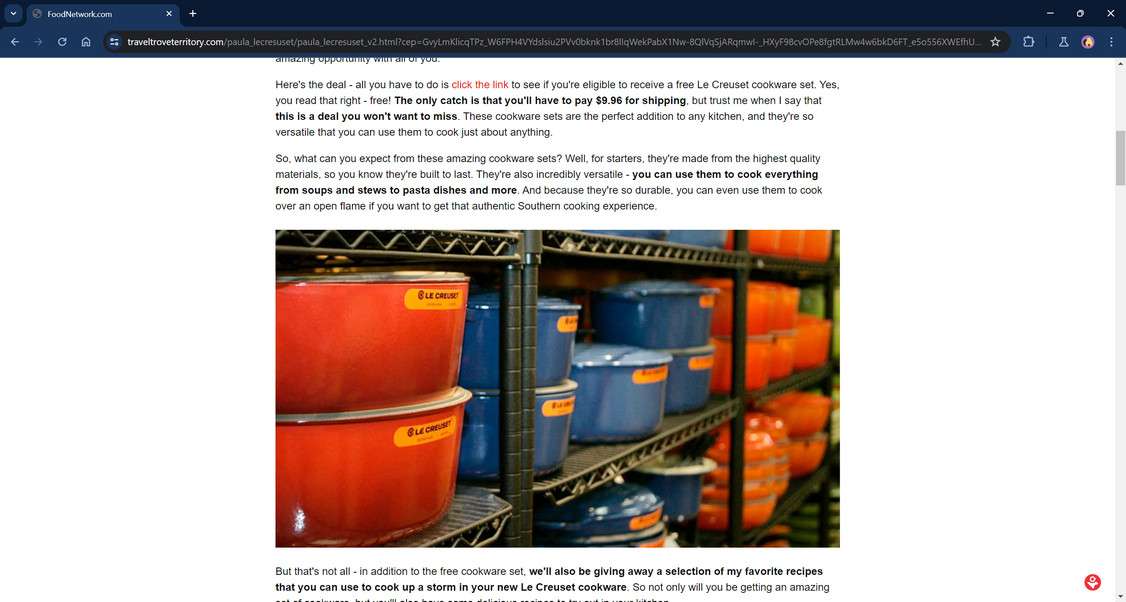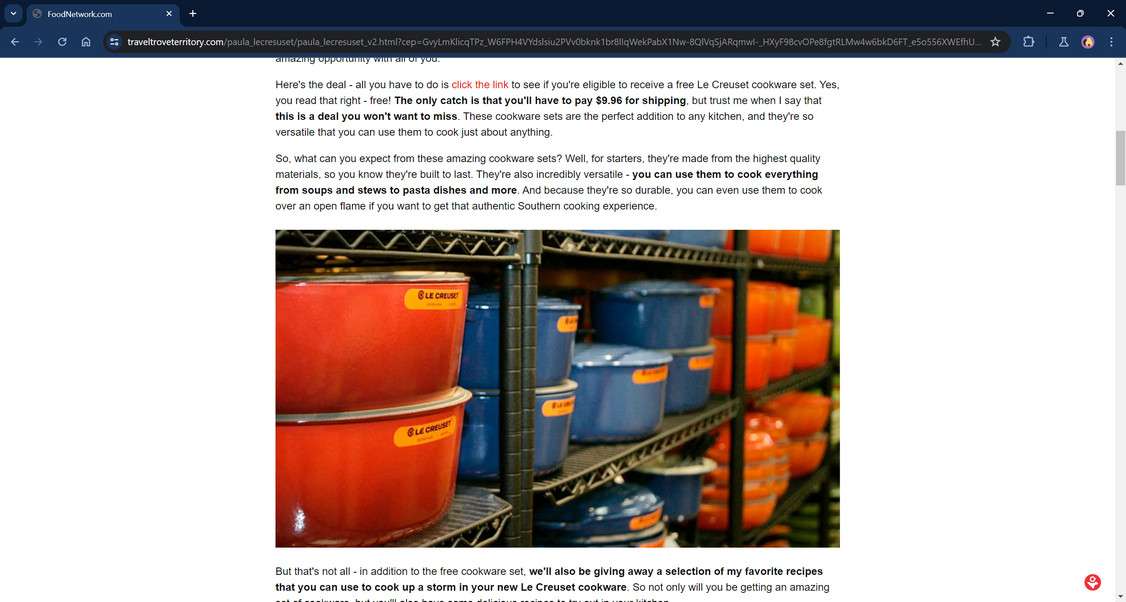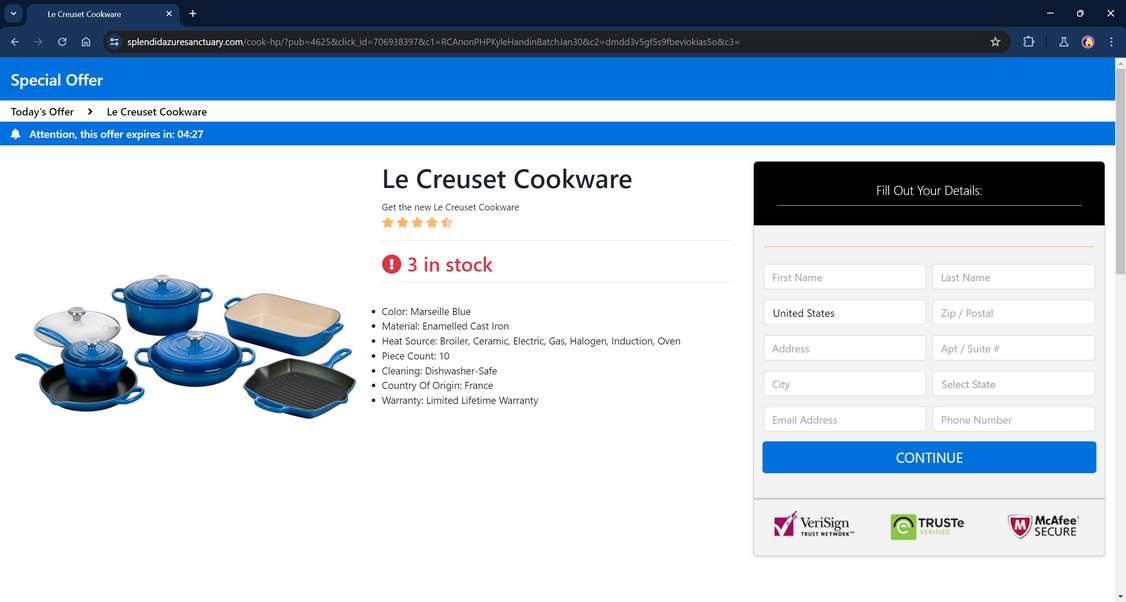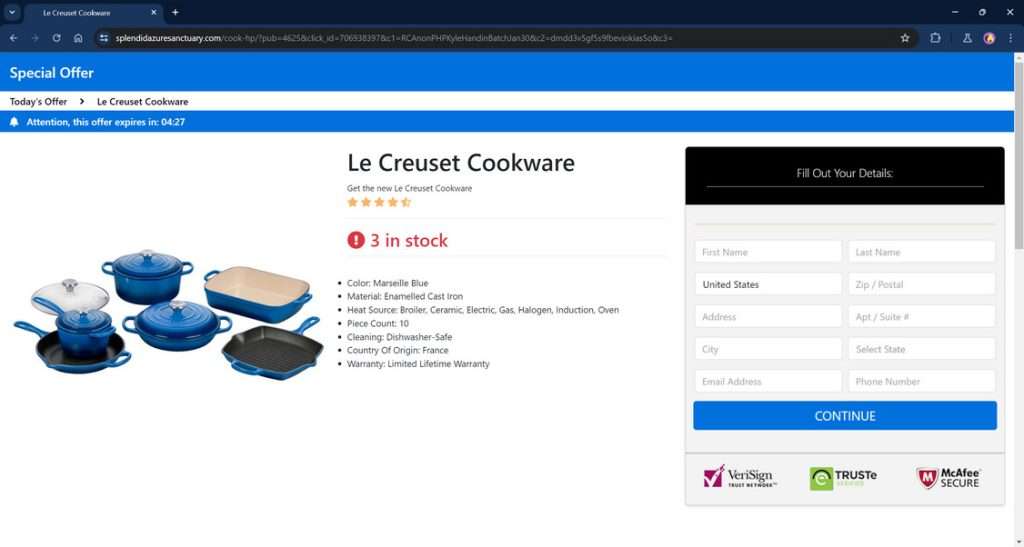If you see social media advertisements promoting Drew Barrymore gifting free Le Creuset cookware, stop right there. This is an elaborate online scam designed to bait victims and steal their money.
In this extensive article, we will take a deep dive into how this predatory scam ensnares consumers, provide tips on avoiding it, and help those who unfortunately got tricked.



This Article Contains:
Scam Overview
This incredibly deceptive scam exploits Drew Barrymore’s celebrity status and likeness to promote fake Le Creuset cookware giveaways across social platforms. It lures victims by fabricating an elaborate promotional campaign before stealing their money through hidden subscription fees.
The scam proliferates via sponsored video ads and posts on sites like YouTube, Facebook, Instagram and TikTok. These ads leverage deepfake AI to mimic Chrissy herself announcing exclusive deals gifting free Le Creuset cookware sets worth over $500 to select fans.

In the AI-generated footage, Chrissy cites reasons like needing to clear excess inventory or mislabeled products as justification for gifting the pricey cookware. The ads strongly urge viewers to click through to claim their free set.
Some examples of the fabricated video ad captions include:
- “Y’all, we’ve got too many Le Creuset sets after a packing mishap! First 5000 fans to click below get a set for free!”
- “Hey y’all! Thanks to a labeling error we’re giving away 1000 Le Creuset sets for FREE if you click below fast!”
- “I’ve teamed up with Le Creuset to gift cookware sets from cancelled big retailer orders! Click below to claim this exclusive giveaway!”
The consistent scam narrative promotes a sense of urgency, exclusivity, and high perceived value of the fictional giveaway. But it’s completely false.
After baiting victims via social media, the scam directs them through a sequence of deceptive websites and forms aiming to ultimately harvest personal and financial information.
First, the social posts redirect to sham “news” articles published on fake domains posing as authoritative outlets like Fox News, USA Today, and more. These fluent articles echo the fraudulent Drew Barrymore partnership and cookware gift narrative.
High-resolution Le Creuset product images make the free offer seem even more realistic. The articles use SEO keywords and natural writing to boost their search visibility – lending to their façade.
After consuming the fake news reports, users reach mocked up Le Creuset or Drew Barrymore product listing pages showcasing pricey cookware sets offered for free or huge discounts.
These showcase sites utilize stolen Le Creuset assets like the signature cursive fonts and swirling orange accents to appear legitimate. Users see the familiar branding associated with Le Creuset.
The only “fee” mentioned is a reasonable $4.99 – $9.96 shipping and handling cost. This is itself another ruse, as revealed later.

With defenses lowered by the perceived amazing deal, users are prompted to “confirm eligibility” by providing personal information and crucially, credit card details to cover shipping.
In reality, by submitting their card number, victims are auto-enrolled into costly monthly subscription plans without consent, often exceeding $79 per month. No free products are ever delivered.
This extremely deceptive scam relies on deepfake media, fake websites, and faulty celebrity associations to successfully dupe consumers. The bait of free gifts from Drew Barrymore herself drives engagement through its sequence of false promises.
Ultimately, it exploits Chrissy’s reputation and brand by forging her endorsement through AI. This allows the scammers behind the facade to steal user data and money before the deceit is uncovered.
This scam has been also investigated by Jordan Liles on his YouTube channel, where he offers a detailed video on the subject. We recommend watching his content for a comprehensive understanding of the scam.
Next, let’s break down exactly how scammers carry out this scam from start to finish.
How the Scam Works
Here is an in-depth look at the step-by-step methods this Drew Barrymore free cookware scam employs to gradually deceive and exploit targets:
Stage 1: Misleading Social Media Ads
The first phase involves bots and fake accounts spreading sponsored video and image-based social media ads featuring Drew Barrymore herself promoting the phony giveaway promotion.
These polished ads leverage deepfake AI to accurately mimic Chrissy announcing an exclusive Le Creuset cookware set giveaway in partnership with the brand. Various reasons are cited, like excess inventory or a special holiday partnership deal.
Sly psychological tactics are used in these ads, like conveying scarcity and urgency to complete the offer before it’s “too late.” Chrissy’s fun personality is also exploited to build quick rapport and trust with viewers.
Stage 2: Fake News Articles Adding Credibility
After clicking the social media ads, users are taken to a series of spoofed “news” articles hosted on fake domains pretending to be Fox News, Buzzfeed, USA Today, and more.
These articles echo the narrative from the ads, using flowing language about Chrissy’s “limited-time” partnership with Le Creuset to gift free luxury cookware to a select group of devotees.
Stolen media assets like Drew Barrymore photography and the Le Creuset logo help make the pages appear convincing. All content is geared towards establishing legitimacy and affirming the free offer.
Stage 3: Phishing Forms Masquerading as Le Creuset
Scam pages modeled after Le Creuset’s real website come next. These showcase the familiar orange branding accents and cursive fonts associated with Le Creuset, advertising the Drew Barrymore promo.
Users are pushed to “claim” the free cookware set by entering personal details like name, home address, email, phone number, and crucially, credit card information – solely to pay a small $4.95 shipping fee.
In reality, these sites are not affiliated with Le Creuset. By handing over payment information, victims enable chrarges for unwanted subscriptions.
Stage 4: Auto-Enrollment in Recurring Subscriptions
Although users believe they are only paying shipping fees, the credit card information they provide automatically enrolls them into high-cost monthly subscription plans.
These range from $79.99 to even $299.99 each month for memberships providing vague perks like “access to VIP shopping privileges.” Users are not clearly informed of the true nature of these subscriptions.
Cancelling these memberships is notoriously difficult too, as shady merchants tend to ignore requests or obstruct the process. So victims continue racking up ridiculous fees.
Stage 5: No Free Cookware Arrives
Despite moving through all steps expecting Chrissy’s promised free Le Creuset cookware, the victims ultimately receive nothing in the mail.
The fictional gift was simply bait to progress targets through the various fronts designed to gradually harvest information and generate recurring subscription revenue.
At the end, users have their data compromised, bank accounts charged repeatedly, no cookware, and the realization it was all an elaborate ruse. The phony promise of a celebrity giveaway enabled the scammers to profit off stolen details.
How to Identify This Fake Drew Barrymore Cookware Giveaway
Unfortunately, crafty scammers are getting increasingly convincing at disguising their deceitful promotions as legitimate giveaways. But there are telltale signs you can watch for to avoid getting duped by this fake Drew Barrymore free cookware scam:
1. Look for Use of AI Deepfake Technology
A major red flag is if the Drew Barrymore videos or voice recordings promoting the giveaway seem just slightly “off.” Subtle unnatural facial movements or speech irregularities could indicate an AI deepfake produced without Chrissy’s real participation.
2. Language That Incites Urgency
Phrases like “limited time only!” or “Hurry, supplies running out fast!” are common scam tactics to create false urgency. Reputable brands rarely hype giveaways this aggressively. Big warning sign if they try pressuring you to act immediately.
3. Too-Good-to-Be-True Pricing
Rationalize the offer. Why would a premium brand give away top-tier cookware absolutely free without an obvious profit motive? If it seems too good to be true, it nearly always is.
4. Look for Fake News Articles
Scammers often include fake news articles to establish credibility. But look closely – the articles are hosted on shady domains completely unaffiliated with real news sites, despite appearances.
5. Verify Blue Checkmarks on Social Accounts
Legitimate celebrity social media accounts have a blue verification checkmark. A missing checkmark on sponsored giveaway posts claiming to be from a celebrity is a clear indicator of a scam.
6. Research Current Brand Partnerships
Search for any press releases or announcements from Le Creuset and Drew Barrymore officially confirming their joint giveaway. If you find nothing, it’s very likely fabricated.
7. Trust Your Instincts
If any part of the promotion seems “off” or questionable, that’s often your best indicator to avoid the offer entirely. Go with your gut – scams trigger natural skepticism for good reason.
Stay alert! With awareness of how this scam works, hopefully you can spot the deceit before getting duped. Remember, if an offer looks fake, it almost certainly is.
What To Do If You Are a Victim
If you unfortunately fell for the invented Drew Barrymore and Le Creuset giveaway promotion and are now stuck with unwanted charges, here are some damage control tips:
- Immediately notify your credit card company of the fraudulent charges so they can block and refund the payments. Cancel any active subscriptions still linked to your card.
- Closely monitor your statements for any additional suspicious charges from entities you don’t recognize. Dispute them promptly.
- Consider changing account passwords that may have been compromised if you used the same ones across scam sites. Enable two-factor authentication where possible.
- Contact the three major credit bureaus to place an initial fraud alert on your credit file. This flags any unusual activity for review.
- Report the scam to the FTC to log an official complaint about the crime and help warn others.
- Leave comments about the scam on Drew Barrymore and Le Creuset’s official social media pages warning others. Also notify Facebook, Instagram, etc.
- Spread awareness among family and friends to prevent them from also falling victim to celebrity free gift scams. Education is key.
Frequently Asked Questions About the Drew Barrymore Le Creuset Giveaway Scam
1. Is the Drew Barrymore free Le Creuset cookware giveaway real?
No. This is a fake giveaway scam designed to mislead social media users. Drew Barrymore and Le Creuset have no actual affiliation with the promotion. The deepfake videos and claims of excess inventory being given away for free are false. This is a scam through-and-through.
2. How does the Drew Barrymore Le Creuset cookware giveaway scam work?
The multi-stage scam works by first luring victims through deceptive social media ads featuring AI-generated footage of Drew Barrymore announcing the fake promotion. Users are funneled through a sequence of fake news articles, product listings, and order forms tricking them into entering personal information and credit card numbers. Victims are then unwillingly signed up for expensive monthly subscription plans without their consent.
3. What payment and personal information do you have to provide?
The scam requests users enter details like their name, home address, phone number, email address, and crucially their credit card number under the guise of paying shipping fees for the free cookware set. Entering credit card data enrolls victims in costly monthly subscription plans exceeding $79 per month.
4. What happens after you enter your payment information?
Right after users enter credit card information, they are automatically signed up for overpriced subscription plans without any confirmation. These useless subscriptions can be very difficult to cancel. Victims never receive any free cookware despite completing the steps. The promoters behind the scam immediately monetize stolen user data.
5. How much does the Drew Barrymore Le Creuset giveaway scam cost?
While the ads emphasize that the Le Creuset cookware sets are completely free, entering a credit card triggers subscriptions costing $79.99-$99.99 per month. These charges recur continuously each month until users are able to successfully cancel the plans. Total costs add up quickly over time.
6. What are common excuses used for the fake giveaway?
Common reasons used in the deceptive ads include clearing excess inventory, mislabeled products, retailer order cancellations, limited holiday promotions, or birthday celebrations. The variety of excuses aim to seem plausible but are complete fabrications meant to drive interest.
7. Are there any real free Le Creuset giveaways hosted by Drew Barrymore?
No, there are currently no legitimate giveaways for free Le Creuset products being offered by Drew Barrymore in affiliation with the brand. All promotions featuring Drew Barrymore giving away free Le Creuset cookware sets are scams regardless of what social media ads may claim.
8. How can you tell the Drew Barrymore free cookware ads are fake?
Indicators include too-good-to-be-true offers, low shipping fees, usage of fake celebrity deepfakes, and flashy urgency tactics. Legitimate brands do not give away expensive products for free without obvious profit benefit. Proceed with extreme caution regarding online free gift promotions using celebrities.
9. What should you do if you already fell victim to the scam?
First, contact your credit card company to report unauthorized charges. Place fraud alerts, reset account passwords that may have been compromised, monitor your statements closely for other suspicious charges, and be vigilant for any signs of wider identity theft. You can also file formal complaints against the scam with the FTC.
10. How can you avoid these Drew Barrymore free cookware scams?
Stay skeptical of giveaways that seem unrealistic or urgently push you to act fast. Vet links carefully before clicking. Avoid entering personal information unless on a verified domain. Be extra cautious regarding social media promotions involving celebrity endorsements or free luxury gifts. If an offer appears fake, it very likely is.
The Bottom Line
This Drew Barrymore x Le Creuset cookware giveaway scam shows incredible levels of deception and manipulation tactics to lure social media users into handing over personal data that enables financial theft.
From deepfake media impersonation to fake news articles and spoofed websites, an entire faux promotional universe is fabricated to bestow legitimacy on a completely false offer.
The promise of free luxury products under the guise of a celebrity partnership is an extremely effective psychological ploy to lower defenses. But users must remember if an offer appears too good to be true, it certainly is.
Always exercise extreme caution around social media giveaways involving celebrities and expensive merchandise provided for free. Verify claims directly with brand sources and check for obvious scam indicators. Avoid entering personal information on questionable domains.
We hope this extensive guide can help protect more vulnerable consumers from predatory scams seeking to do harm under the mask of fun gift giveaways. Just remember – celebrities are not randomly giving away $500 cookware, no matter what that Instagram ad claims!










